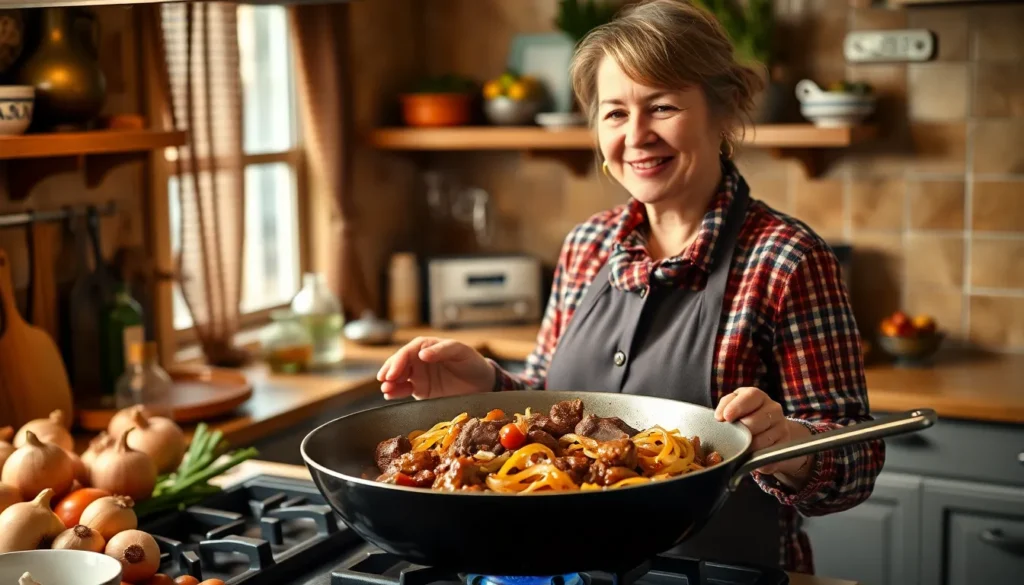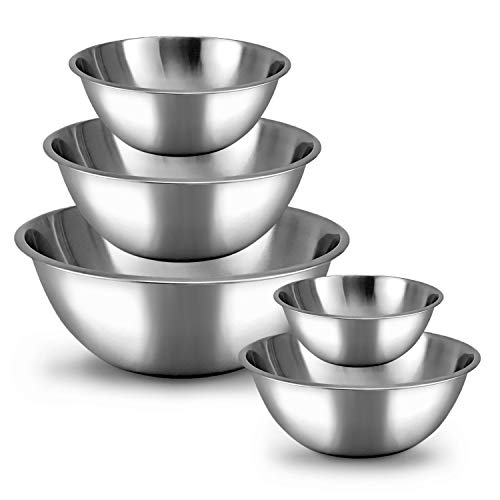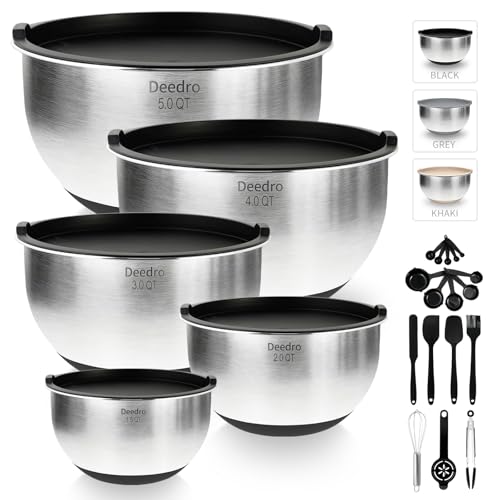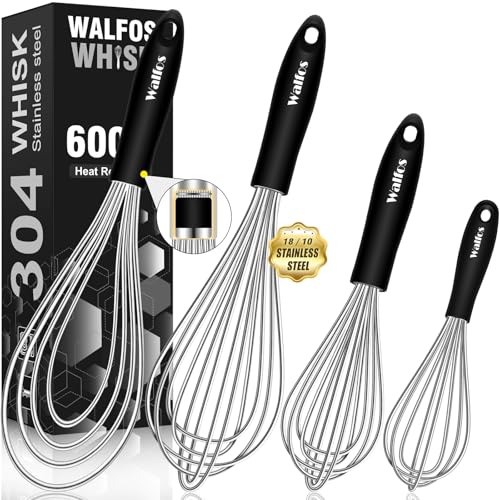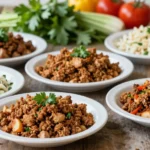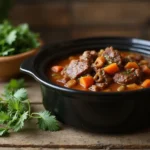Beef liver and onions might sound intimidating but it’s actually one of the most nutrient-dense and flavorful meals you can make at home. This classic comfort food has been nourishing families for generations and we’re here to show you exactly how to prepare it perfectly every time.
The secret to amazing liver and onions lies in proper preparation and cooking technique. Many people shy away from organ meats because they’ve had poorly prepared versions but when done right this dish becomes incredibly tender and delicious. The sweet caramelized onions balance the rich mineral flavor of the liver creating a harmonious combination that’ll surprise even the most skeptical eaters.
We’ll walk you through each step from selecting the best liver to achieving that perfect golden-brown sear. Our foolproof method ensures you’ll end up with tender liver that’s never tough or overcooked paired with beautifully caramelized onions that add sweetness and depth to every bite.
Ingredients
We’ve carefully selected each ingredient to ensure our beef liver and onions delivers maximum flavor while maintaining the tender texture that makes this dish irresistible. These simple components work together to create a restaurant-quality meal in your own kitchen.
For the Beef Liver
- 1 pound beef liver, sliced into ½-inch thick pieces
- 2 cups whole milk for soaking
- 1 teaspoon kosher salt for the milk bath
For the Onions
- 3 large yellow onions, sliced into ¼-inch rings
- 2 tablespoons unsalted butter
- 1 tablespoon olive oil
- 1 teaspoon granulated sugar
- ½ teaspoon kosher salt
- ¼ teaspoon black pepper
For the Coating and Seasoning
- 1 cup all-purpose flour
- 1 teaspoon garlic powder
- 1 teaspoon onion powder
- 1 teaspoon smoked paprika
- ¾ teaspoon kosher salt
- ½ teaspoon black pepper
- ¼ teaspoon cayenne pepper
- 3 tablespoons vegetable oil for frying
- 2 tablespoons unsalted butter for finishing
Equipment Needed
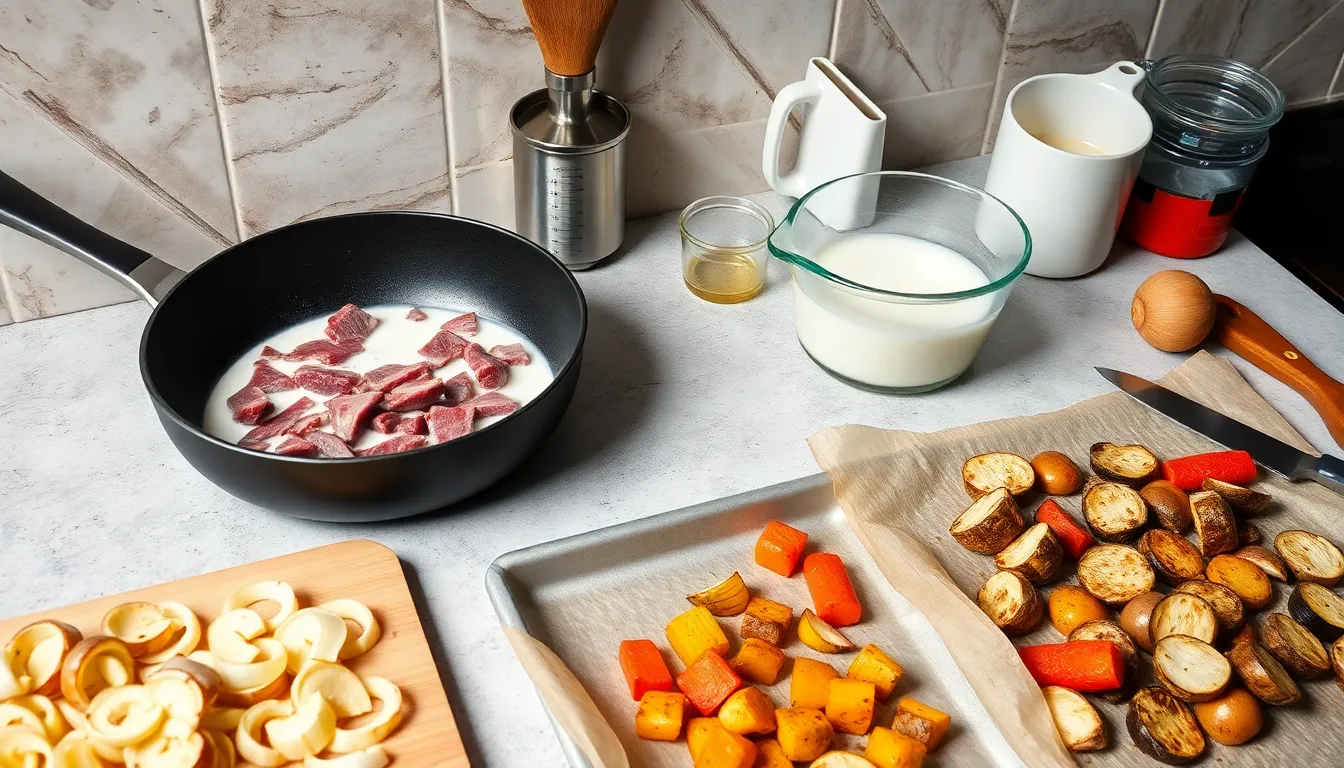
Having the right kitchen tools makes all the difference when preparing beef liver and onions. We’ve carefully selected each piece of equipment to ensure your cooking process runs smoothly and delivers exceptional results.
Large skillet or frying pan serves as our primary cooking vessel. We recommend using a non-stick or cast iron option for optimal heat distribution and easy cleanup. The generous surface area allows us to cook the liver without overcrowding while maintaining proper temperature control.
Mixing bowl becomes essential for soaking the liver in milk. This crucial step requires a bowl large enough to fully submerge the liver pieces while allowing easy access for removal.
Tongs or spatula provide precise control when flipping the delicate liver pieces and stirring the caramelizing onions. These tools prevent tearing and ensure even cooking throughout the process.
Plate or tray offers a designated resting area for the cooked liver. This prevents overcooking and allows the meat to retain its juices while we finish preparing the onions.
Measuring cups and spoons ensure accuracy in our recipe proportions. Precise measurements guarantee consistent results every time we prepare this dish.
Knife and cutting board handle the prep work efficiently. We use these for slicing onions to uniform thickness and cutting liver into appropriate portions if needed.
Optional sheet tray with parchment paper comes in handy when serving roasted vegetables alongside our main dish. This additional equipment expands our meal options without requiring extra stovetop space.
Each piece of equipment serves a exact purpose in creating tender liver with perfectly caramelized onions. The combination of proper tools and technique transforms this traditional dish into a restaurant quality meal prepared in our own kitchen.
Prep Work
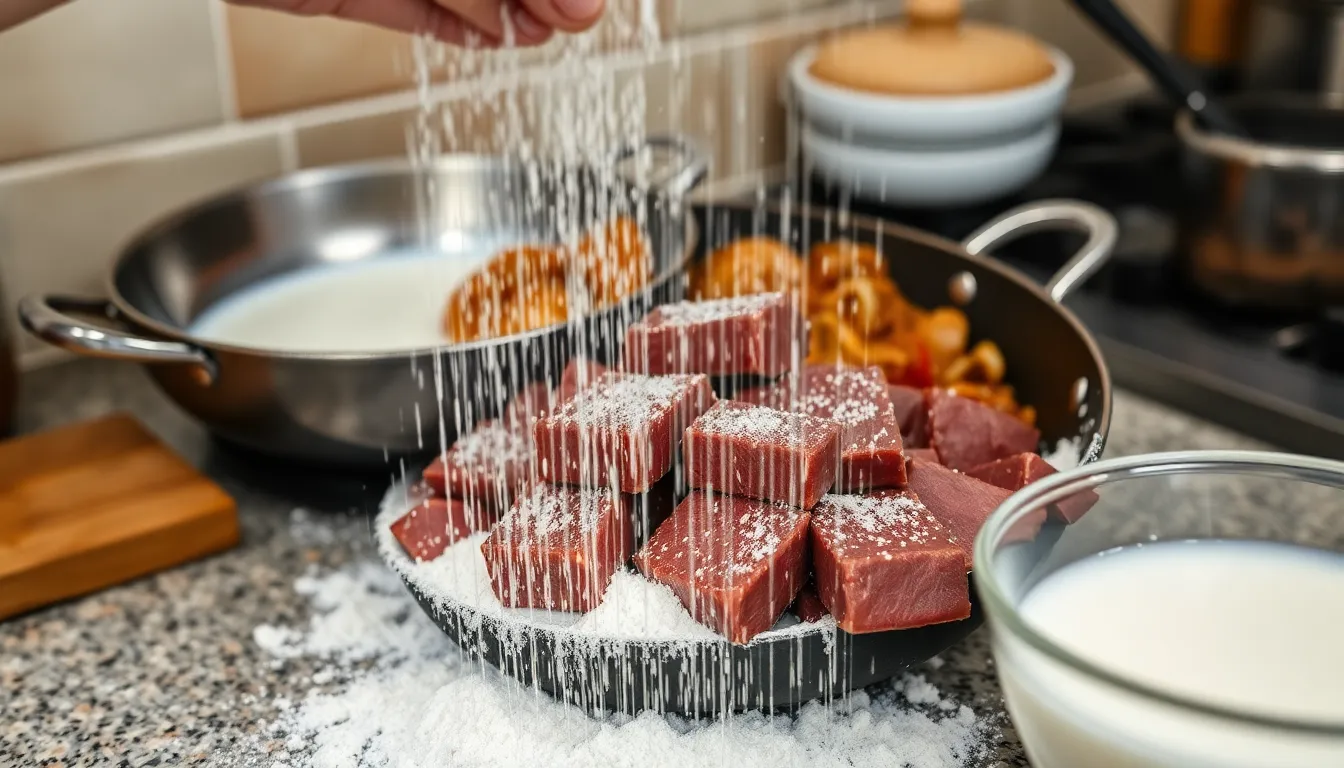
Proper preparation sets the foundation for transforming beef liver into a tender and flavorful dish. We’ll walk through each essential step to ensure your liver and onions turn out perfectly every time.
Preparing the Beef Liver
We start with 2 pounds of sliced beef liver or calf liver for the most tender results. Calf liver offers a milder flavor that appeals to those new to organ meats.
Soaking the liver slices in milk for 30 minutes to 1 hour before cooking removes any bitter taste and improves the texture significantly. This crucial step makes the difference between tough liver and melt-in-your-mouth tenderness.
After soaking, we pat the liver dry with paper towels to remove excess moisture. Seasoning comes next with a simple combination of salt and pepper applied evenly to both sides.
Dredging the liver slices in all-purpose flour creates a beautiful golden crust when cooked. We season our flour with salt, pepper, and optionally garlic powder or paprika for extra flavor depth. Shaking off excess flour prevents a heavy coating that could burn during cooking.
Preparing the Onions
We use 2 large Vidalia onions or any sweet yellow onions for the best caramelized results. Sweet onions complement the rich liver flavor without overwhelming it.
Peeling and slicing the onions into rings or thin slices ensures even cooking throughout. We separate the rings completely so each piece caramelizes properly in the pan.
These onions will cook in butter, bacon grease, or oil until they reach that perfect soft and golden state. Most recipes call for cooking the onions first, then setting them aside to add back later during the final cooking stage.
Instructions
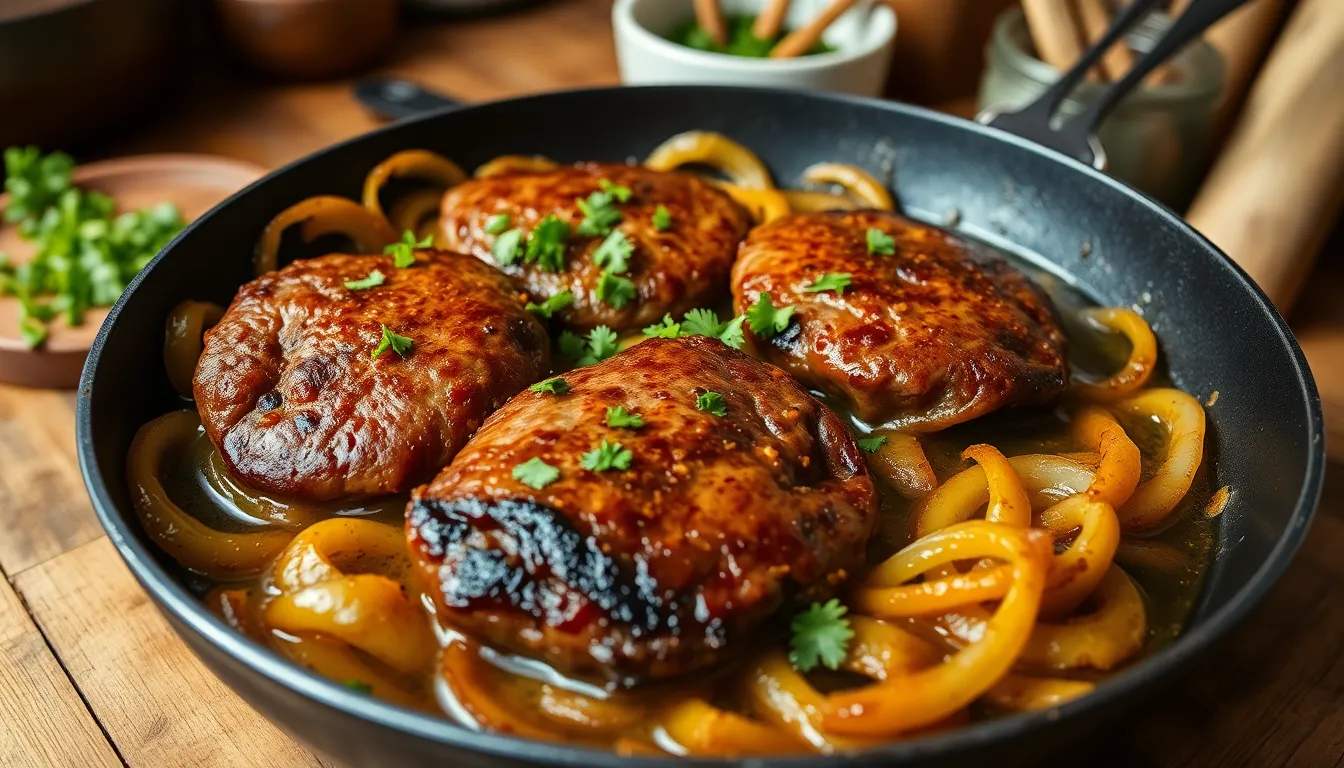
We’ll walk through each step of preparing this classic beef liver and onions dish to ensure tender results every time. Follow our proven method to transform this nutritious organ meat into a restaurant-quality meal.
Soaking the Liver
We start by placing our 1 to 2 pounds of sliced beef liver in a large mixing bowl and covering completely with milk. This crucial step removes any bitter compounds while tenderizing the meat fibers. Allow the liver to soak for at least 30 minutes though we recommend extending this to 1 hour for optimal results. The milk neutralizes strong flavors and creates a milder taste that appeals to those new to organ meats.
Coating the Liver
We remove the liver from the milk and gently pat each slice dry using paper towels to ensure proper flour adherence. In a shallow dish we combine all-purpose flour with salt pepper and optional garlic powder for enhanced flavor. Each liver slice gets coated evenly with our seasoned flour mixture which creates the foundation for a beautiful golden crust. We shake off any excess flour to prevent clumping during the cooking process.
Cooking the Onions
We heat butter or olive oil in our large skillet over medium heat until it begins to shimmer. Our 1 to 2 large sliced onions go into the heated fat where they cook slowly until translucent and lightly browned. This process takes approximately 8 to 10 minutes and develops the natural sweetness that balances the rich liver flavor. We remove the caramelized onions from the skillet and set them aside on a plate to maintain their texture.
Cooking the Liver
We add more butter or oil to the same skillet if needed and increase the heat to medium-high for proper searing. Our flour-coated liver slices go into the hot fat where they cook for 3 to 4 minutes per side until golden brown. We avoid overcooking by reducing heat if the liver browns too quickly since overcooked liver becomes tough and loses its tender texture. The internal temperature should reach 145°F for food safety while maintaining juiciness.
Combining and Finishing
We return our caramelized onions to the skillet with the seared liver and gently combine the ingredients. A small amount of water or broth may be added if the mixture appears too dry or begins sticking to the pan. We simmer everything together for 2 to 3 minutes allowing the flavors to meld while the onions finish caramelizing to a rich golden color. The finished dish should have tender liver paired with sweet caramelized onions ready to serve alongside mashed potatoes or roasted vegetables.
Cooking Tips for Perfect Results
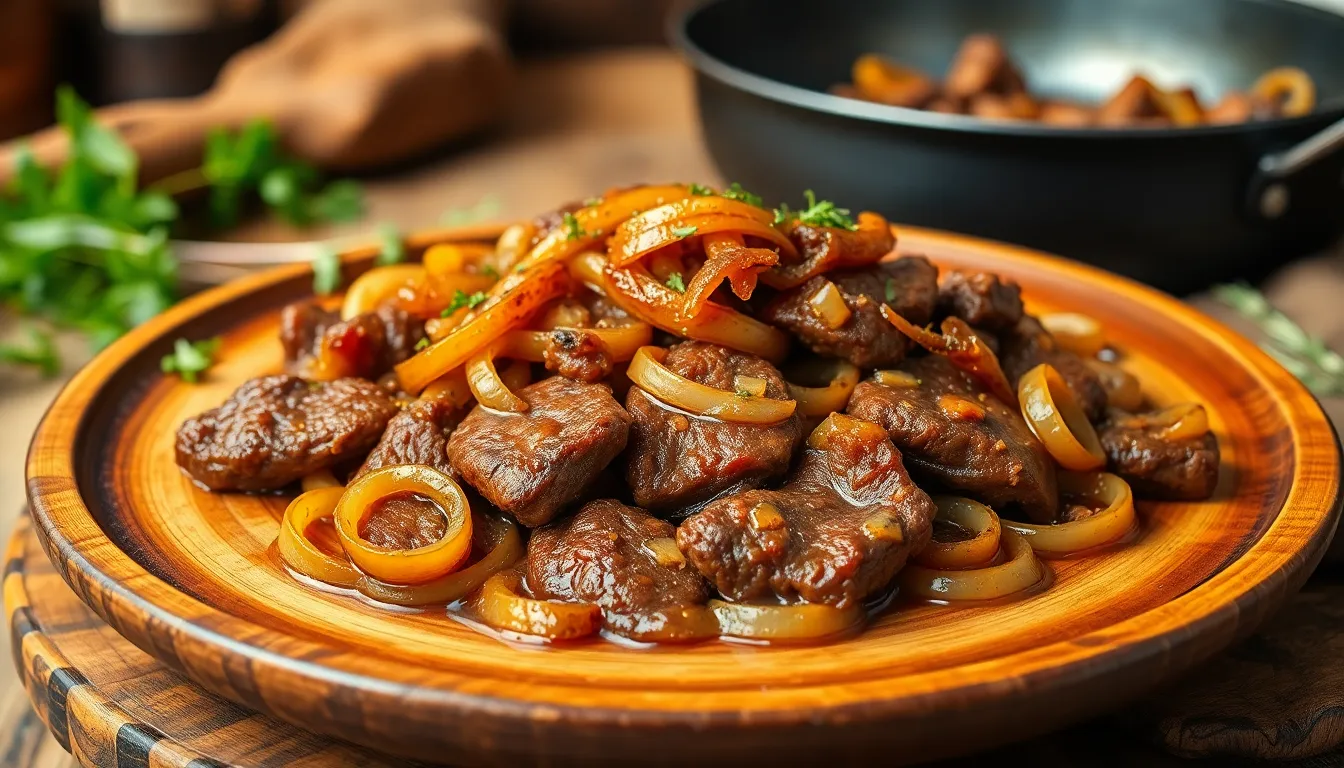
Mastering beef liver and onions requires attention to exact techniques that transform this challenging protein into a tender and flavorful dish. We’ve gathered the most effective methods to ensure your liver turns out perfectly every time.
Soaking the liver in milk serves as our most crucial step for success. This technique significantly reduces bitterness and mellows the strong flavor that many find off-putting. We recommend soaking for at least 30 minutes, though up to one hour provides even better results. The milk draws out impurities and creates a more palatable taste profile.
Young calf liver delivers superior results compared to mature beef liver. We prefer calf liver because it offers a milder flavor and more tender texture. When shopping, look for liver that appears bright and fresh without any dark spots or strong odors.
Timing becomes critical when cooking liver. We never overcook this delicate protein because it quickly becomes tough and develops a grainy texture. The liver should be browned on the outside while remaining tender inside. Cook each slice for approximately 2-3 minutes per side over medium-high heat.
Cooking onions separately first allows us to achieve proper caramelization. We start by sautéing the onions until they become soft and golden, which enhances their natural sweetness. This sweetness provides the perfect complement to the rich liver flavor.
Coating liver in seasoned flour creates multiple benefits. The flour forms a protective crust that seals in moisture while adding texture. We mix salt, pepper, and optional seasonings like garlic powder or paprika into the flour for enhanced flavor.
| Cooking Method | Temperature | Time per Side | Result |
|---|---|---|---|
| Pan Searing | Medium-High | 2-3 minutes | Golden crust, tender inside |
| Gentle Simmer | Medium-Low | 7-8 minutes covered | Extra tender texture |
Adding water and simmering after the initial browning provides additional tenderness. We pour a small amount of water into the skillet, cover, and simmer for 7-8 minutes. This gentle cooking method further softens the liver without overcooking.
Neutral oils like peanut oil work best for frying because they don’t compete with the liver’s flavor. But, we also recommend butter or bacon grease for added richness. Each fat brings its own character to the final dish.
Simple seasoning allows the natural flavors to shine through. We stick to salt and pepper as our base, then add garlic powder, onion powder, or smoked paprika for depth. Over-seasoning can mask the liver’s unique taste that we work so hard to perfect.
Heat management prevents tough, rubbery results. We maintain consistent medium-high heat for searing, then reduce to medium-low for any additional cooking. The skillet should be hot enough to create a sizzle when the liver hits the pan.
These techniques combine traditional cooking wisdom with practical applications to create restaurant-quality beef liver and onions at home. Each step builds upon the previous one to ensure optimal flavor and texture in every bite.
Serving Suggestions
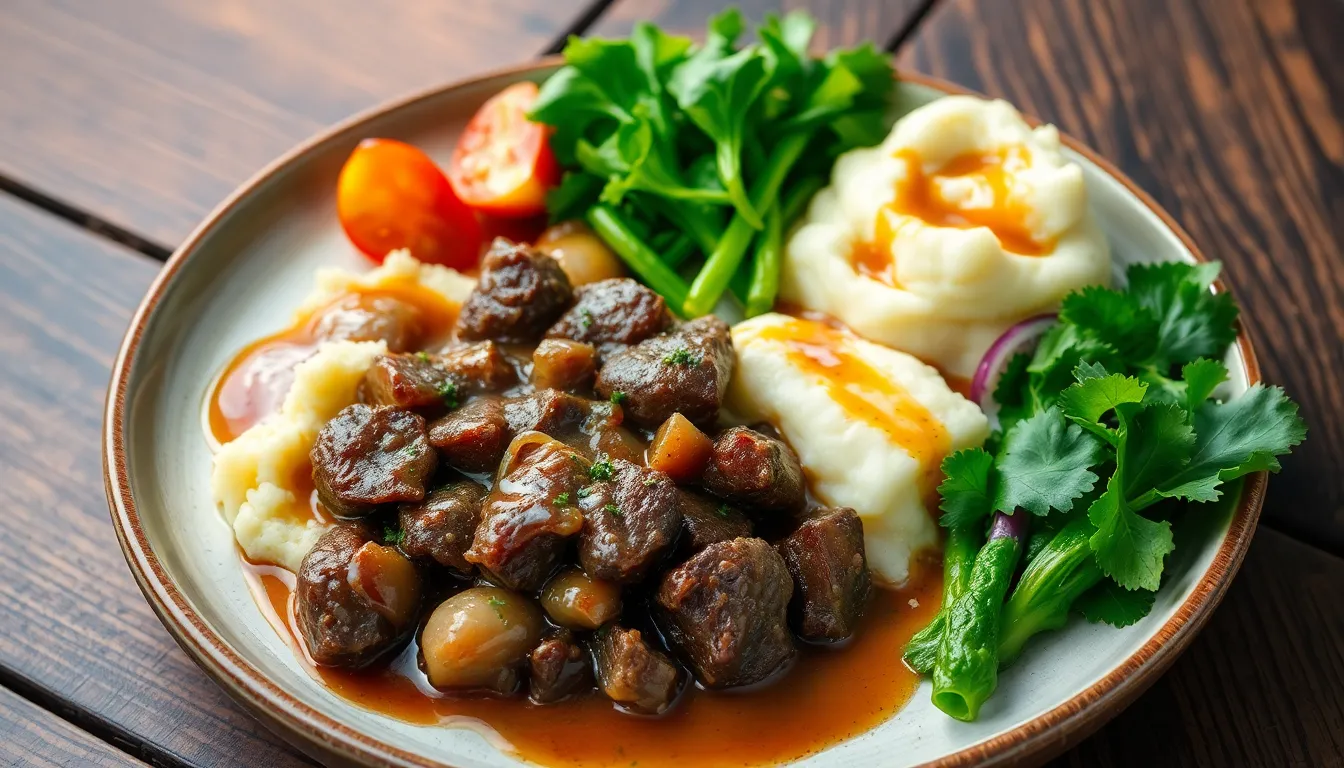
Mashed potatoes stand as the most traditional and beloved accompaniment to beef liver and onions. We recommend preparing creamy butter-enriched mashed potatoes that complement the rich flavors of the liver while providing a comforting base for the caramelized onions and pan juices.
Cooked white rice offers another excellent foundation for this hearty dish. The neutral flavor of rice allows the savory liver and sweet onions to shine while absorbing any delicious pan drippings you’ve created during cooking.
Green vegetables provide essential balance to this protein-rich meal. We suggest serving sautéed broccoli, steamed asparagus, or braised collard greens alongside your liver and onions. These vegetables add color, nutrition, and a fresh contrast to the robust flavors of the main dish.
A simple side salad brings brightness to the plate and helps cleanse the palate between bites. Mixed greens with a light vinaigrette work particularly well, as the acidity cuts through the richness of the liver and butter-cooked onions.
Creating a simple gravy from your pan drippings elevates the entire meal. After cooking the liver and onions, add a tablespoon of flour to the remaining fat in the skillet, then gradually whisk in water or milk to create a smooth gravy that ties all the flavors together.
| Serving Option | Best Pairing Reason |
|---|---|
| Mashed Potatoes | Most traditional, absorbs flavors well |
| White Rice | Neutral base, soaks up pan juices |
| Green Vegetables | Adds color and nutritional balance |
| Side Salad | Provides palate-cleansing contrast |
| Pan Gravy | Enhances overall flavor integration |
Serve your beef liver and onions immediately while hot for the best texture and flavor experience. The liver maintains its tenderness when served fresh from the skillet, and the caramelized onions retain their perfect consistency.
Storage and Reheating Instructions
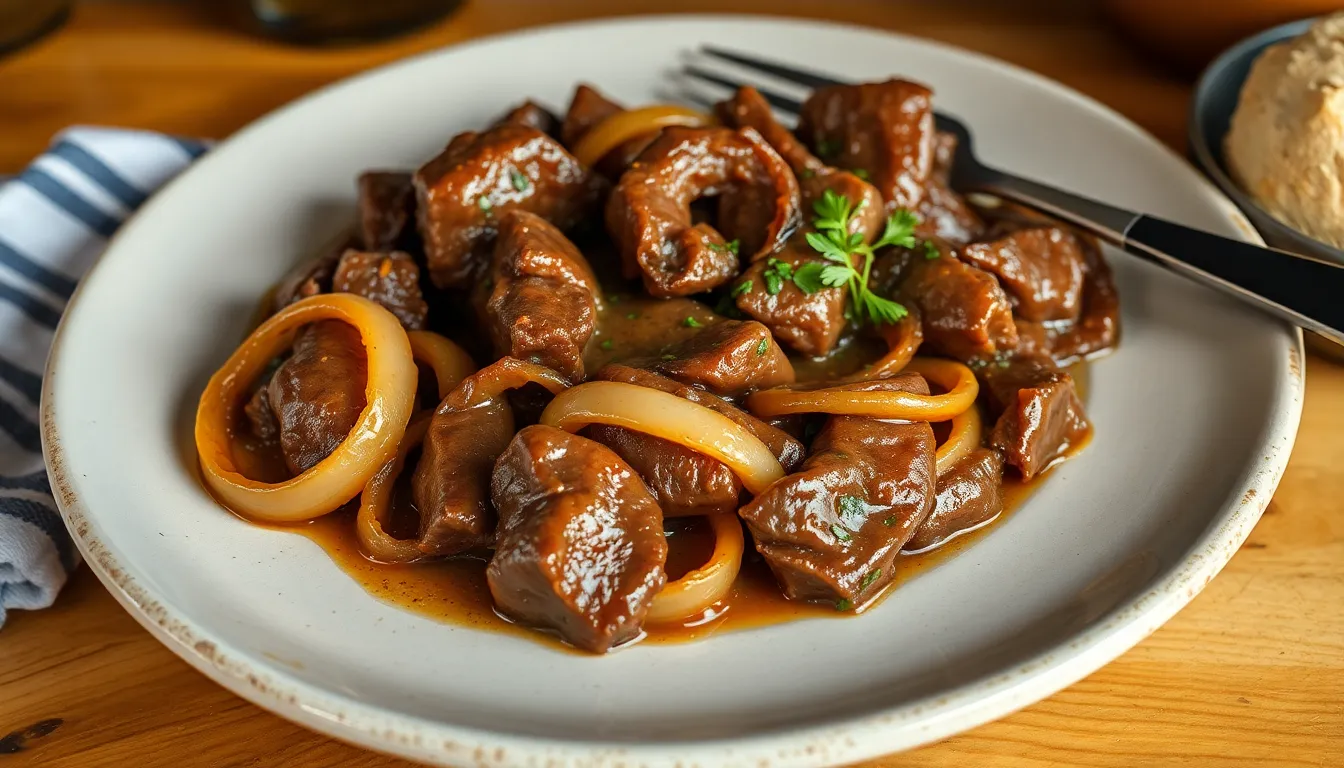
We understand that proper storage and reheating techniques are crucial for maintaining the quality and safety of your beef liver and onions. After enjoying this delicious meal, you’ll want to preserve any leftovers while ensuring they remain tender and flavorful.
Proper Storage Methods
Allow your cooked beef liver and onions to cool completely to room temperature before storing. We recommend transferring the leftovers to an airtight container to prevent moisture loss and maintain optimal freshness. The key to preserving both flavor and texture lies in keeping the liver submerged in the cooking juices or gravy from the pan.
Store your leftover beef liver and onions in the refrigerator for optimal safety and quality. The dish will maintain its best flavor and texture when consumed within the recommended timeframe shown below:
| Storage Method | Temperature | Duration |
|---|---|---|
| Refrigerated | 35-40°F | 3-4 days |
Reheating Techniques for Best Results
We recommend reheating your beef liver and onions gently to prevent the meat from becoming tough or overcooked. Place the leftovers in a skillet over low to medium heat, allowing them to warm gradually. Add a splash of water or milk if the gravy appears too thick, which helps maintain moisture and prevents the liver from drying out.
Microwave reheating offers a convenient alternative when time is limited. Transfer the liver and onions to a microwave-safe dish and cover to retain moisture. Heat in short intervals of 30 seconds, stirring occasionally to ensure even heating throughout the dish.
Monitor the internal temperature carefully during reheating to avoid overcooking the liver. The meat should be heated through but remain tender, with the onions maintaining their caramelized sweetness. We suggest tasting and adjusting seasoning if needed before serving your reheated beef liver and onions.
Nutritional Benefits
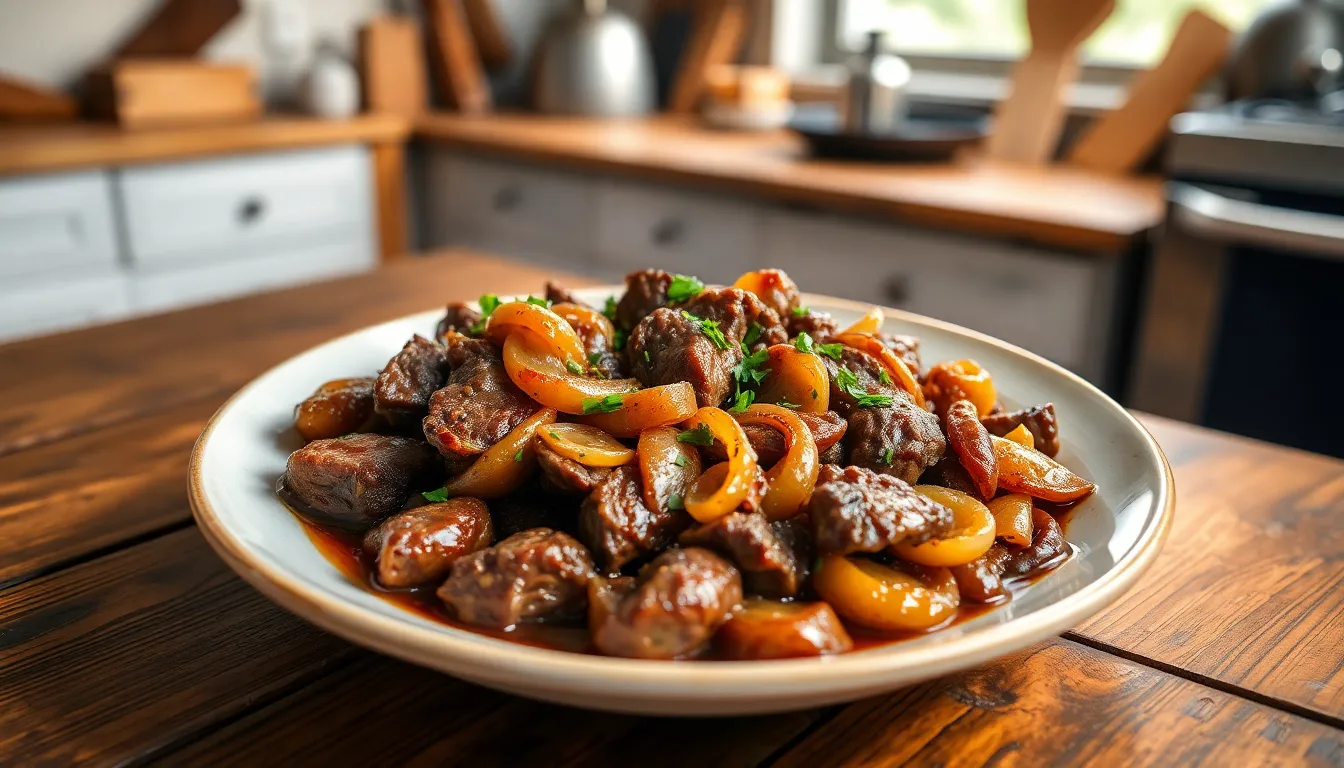
We often underestimate the incredible nutritional power packed into beef liver and onions. This classic dish delivers exceptional health benefits that make it a true superfood combination worth incorporating into our regular meal rotation.
Beef liver stands as one of nature’s most nutrient-dense foods. A single 4-ounce serving provides approximately 153 calories while delivering an impressive 23 grams of high-quality protein and only 4 grams of fat. The macronutrient profile makes this dish ideal for muscle building and weight management goals.
| Nutrient | Amount per 4 oz serving | % Daily Value |
|---|---|---|
| Calories | 153 | 8% |
| Protein | 23g | 46% |
| Fat | 4g | 6% |
| Carbohydrates | 4.4g | 1% |
Iron content in beef liver surpasses most other protein sources significantly. The heme iron found in liver absorbs more efficiently than plant-based iron sources. This makes our beef liver and onions recipe particularly valuable for combating anemia and supporting healthy blood function.
Vitamin A concentration in beef liver reaches extraordinary levels. One serving provides more than the daily recommended amount needed for optimal vision health and immune system support. This fat-soluble vitamin also promotes healthy skin cell regeneration and wound healing.
B vitamins flourish throughout beef liver in remarkable quantities. Vitamin B12 content alone exceeds daily requirements by several times over. These essential nutrients support energy metabolism and maintain proper nervous system function. Folate and other B vitamins work together to support cellular repair and DNA synthesis.
Grass-fed beef liver contains up to four times more nutrients than grain-fed alternatives. We recommend choosing grass-fed options whenever possible for maximum nutritional benefit and better environmental sustainability. The enhanced nutrient density justifies the slightly higher cost for most health-conscious consumers.
The onions in our recipe contribute additional health benefits through quercetin and other powerful antioxidants. These compounds support cardiovascular health and provide anti-inflammatory effects that complement the liver’s nutrient profile perfectly.
Regular consumption of properly prepared beef liver can address common nutritional deficiencies found in modern diets. The bioavailable nutrients absorb readily and provide sustained energy without the crashes associated with processed foods. Our traditional preparation method preserves these vital nutrients while creating an enjoyable dining experience.
Recipe Variations
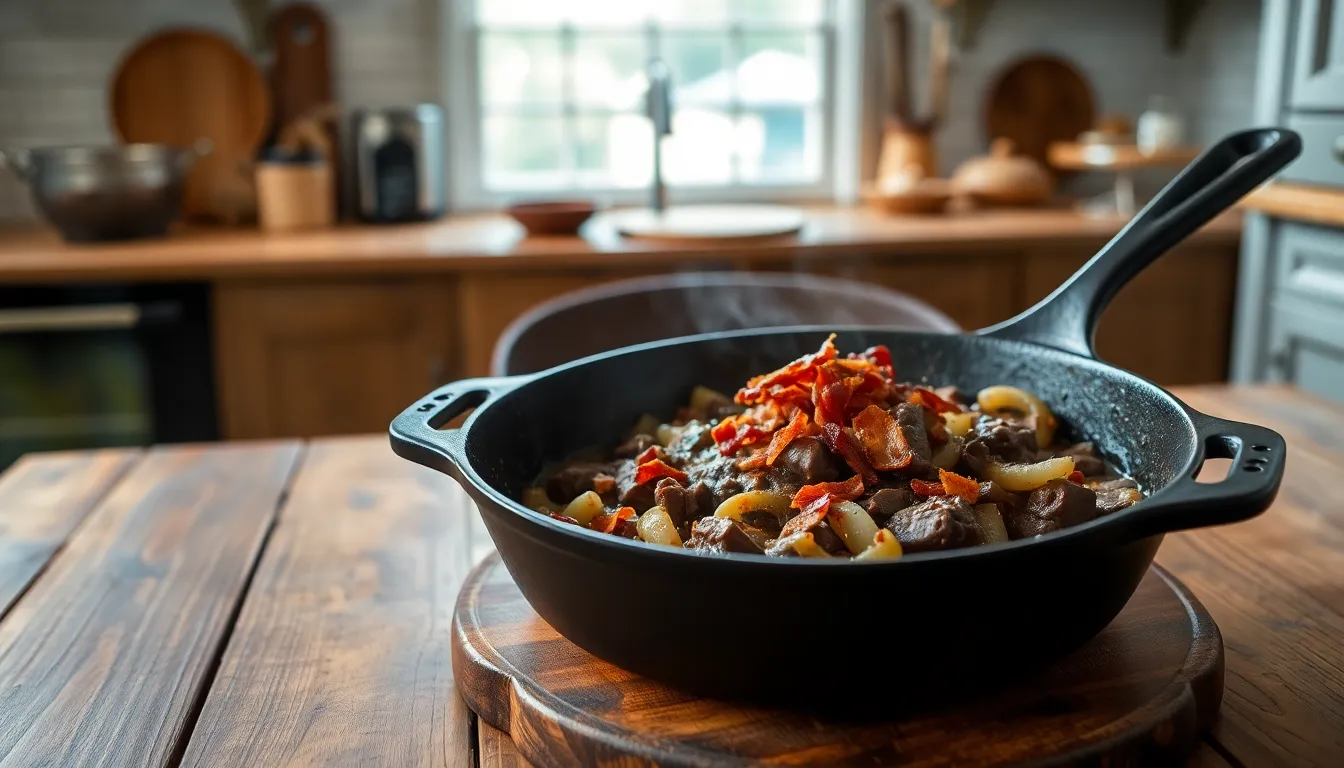
We’ve perfected several variations of this classic dish that cater to different regional preferences and flavor profiles. Each variation maintains the essential technique of soaking liver and caramelizing onions while offering unique twists on seasoning and cooking methods.
Classic Southern Style
Our Southern variation embraces the traditional comfort food approach that transforms simple ingredients into soul-satisfying flavors. We start by heating bacon grease or butter in our cast iron skillet to create that authentic Southern foundation. The liver gets dredged in a seasoned flour mixture containing salt, pepper, and garlic powder for extra depth.
We slice our onions into rings and cook them directly with the liver, creating a harmonious blend of flavors. After adding a splash of water to the skillet, we cover and let everything simmer until the liver reaches perfect tenderness. This method yields a nutrient-dense dish with nostalgic appeal that brings back memories of grandmother’s kitchen.
With Bacon
Adding bacon to our beef liver and onions creates an irresistible combination of smoky richness and enhanced texture. We begin by cutting bacon slices into bite-sized pieces and cooking them until crispy in our large skillet. The rendered bacon fat becomes our cooking medium alongside butter for extra richness.
We cook the bacon pieces along with both the onions and liver, allowing the smoky flavors to permeate every bite. The crisp bacon bits provide a delightful textural contrast to the tender liver and sweet caramelized onions. This variation adds important depth of flavor while maintaining the dish’s traditional cooking techniques.
Mediterranean Style
Our Mediterranean approach lightens the dish while infusing it with herbaceous flavors and aromatic spices. We use olive oil or extra virgin olive oil instead of butter or bacon grease, creating a healthier fat profile without sacrificing taste. The seasoning blend includes garlic powder, smoked paprika, black pepper, and kosher salt for complex Mediterranean flavors.
We prefer thin slices of calf’s liver in this variation since it offers a milder taste that pairs beautifully with the olive oil preparation. The onions get thinly sliced and sautéed separately in olive oil until golden and caramelized, then combined with the liver at the end. This version delivers lighter, more refined flavors while preserving the essential cooking methods that make liver and onions so appealing.
Conclusion
We’ve shared everything you need to master this nutritious and satisfying dish. From proper preparation techniques to cooking tips and storage methods you now have the knowledge to create restaurant-quality beef liver and onions at home.
Remember that soaking the liver and taking your time with the onions makes all the difference. Whether you choose our classic recipe or experiment with the bacon or Mediterranean variations the key is patience and proper technique.
This powerhouse combination delivers exceptional nutrition while honoring traditional cooking methods. We encourage you to give this recipe a try – your taste buds and your health will thank you for it.
Frequently Asked Questions
What is the best way to prepare beef liver to reduce its strong flavor?
Soak the beef liver in milk for 30 minutes to 1 hour before cooking. This technique neutralizes the strong flavors, reduces bitterness, and helps tenderize the meat. After soaking, pat the liver dry and season with salt and pepper before coating in seasoned flour for the best results.
How long should I cook beef liver to keep it tender?
Cook beef liver for 2-3 minutes per side over medium-high heat. Avoid overcooking as this will make the liver tough and rubbery. The liver should be browned on the outside but still slightly pink in the center for optimal tenderness and flavor.
What type of onions work best for liver and onions?
Vidalia or sweet yellow onions are ideal for this dish. These varieties caramelize beautifully and develop natural sweetness that complements the rich flavor of the liver. Slice them evenly and cook slowly in butter or oil until soft and golden brown.
Should I use calf liver or beef liver?
Calf liver is recommended, especially for beginners, as it has a milder flavor and more tender texture compared to beef liver. Calf liver is younger and less developed, making it less intense in taste while still providing the same nutritional benefits.
What equipment do I need to make perfect liver and onions?
You’ll need a large skillet (preferably cast iron or non-stick), mixing bowl for soaking, tongs or spatula for flipping, measuring cups and spoons, knife and cutting board, and a plate for resting. A cast iron skillet provides the best heat distribution for optimal searing.
How should I store leftover liver and onions?
Cool the dish completely before transferring to an airtight container. Store in the refrigerator for 3-4 days, keeping the liver submerged in cooking juices for freshness. Reheat gently in a skillet over low heat or microwave in short intervals to prevent toughness.
What are the nutritional benefits of eating beef liver?
Beef liver is a nutritional powerhouse containing high-quality protein, iron, vitamin A, and B vitamins. It supports immune function, energy production, and helps address common nutritional deficiencies. Grass-fed liver offers even higher nutrient density for maximum health benefits.
What are good side dishes to serve with liver and onions?
Traditional accompaniments include creamy mashed potatoes, cooked white rice, and sautéed green vegetables like broccoli or asparagus. A simple side salad helps cleanse the palate, while homemade gravy from pan drippings can elevate the overall flavor experience.

